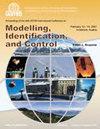Automatic Control of Aircraft Landing by Using the H2/H∞ Control Technique
IF 0.7
4区 计算机科学
Q4 AUTOMATION & CONTROL SYSTEMS
引用次数: 0
Abstract
The paper presents the automatic control of aircraft in longitudinal plane, during landing, by using the linearized dynamics of aircraft, taking into consideration the sensor errors and other external disturbances. Aircraft auto-landing is achieved by combining two control techniques: H2 and H∞ approaches; this way, a robust H2/H∞ controller is obtained. Within the robust H2/H∞ controller, the weights of the H2 and H∞ control techniques are adjusted such that the aircraft accurately tracks the desired trajectory during the two main stages of the landing process (glide slope and flare). The new automatic landing system also consists of: a subsystem which models the geometry of landing, providing the imposed value of aircraft longitudinal velocity and altitude, an optimal observer for the estimation of aircraft state and a dynamic compensator providing one of the two components of the mixed H2/H∞ control law. The theoretical results are validated by numerical simulations for the landing of a Boeing 747; the results are very promising and prove the robustness of the new auto-landing system even in the presence of disturbances.基于H2/H∞控制技术的飞机着陆自动控制
本文利用飞机的线性化动力学,在考虑传感器误差和其他外界干扰的情况下,提出了飞机在纵向平面着陆的自动控制方法。飞机自动著陆是通过H2和H∞两种控制技术的结合来实现的;从而得到鲁棒H2/H∞控制器。在鲁棒H2/H∞控制器中,调整H2和H∞控制技术的权重,使飞机在着陆过程的两个主要阶段(滑降和耀光)中准确地跟踪所需的轨迹。该自动着陆系统还包括:一个模拟着陆几何的子系统,提供飞机纵向速度和高度的强制值,一个用于估计飞机状态的最优观测器和一个动态补偿器,提供混合H2/H∞控制律的两个组成部分之一。通过波音747飞机着陆的数值模拟验证了理论结果;结果表明,即使在存在干扰的情况下,该自动着陆系统也具有良好的鲁棒性。
本文章由计算机程序翻译,如有差异,请以英文原文为准。
求助全文
约1分钟内获得全文
求助全文
来源期刊

Modeling Identification and Control
工程技术-计算机:控制论
CiteScore
3.30
自引率
0.00%
发文量
6
审稿时长
>12 weeks
期刊介绍:
The aim of MIC is to present Nordic research activities in the field of modeling, identification and control to the international scientific community. Historically, the articles published in MIC presented the results of research carried out in Norway, or sponsored primarily by a Norwegian institution. Since 2009 the journal also accepts papers from the other Nordic countries.
 求助内容:
求助内容: 应助结果提醒方式:
应助结果提醒方式:


